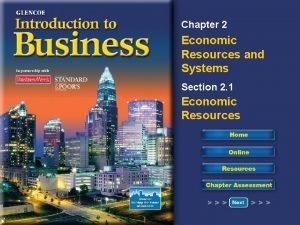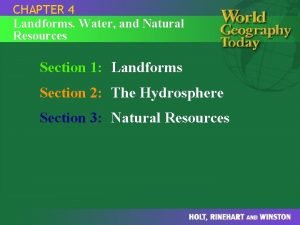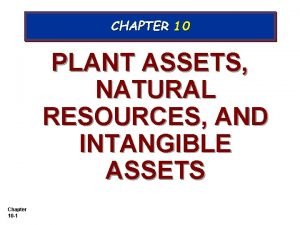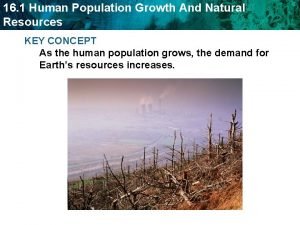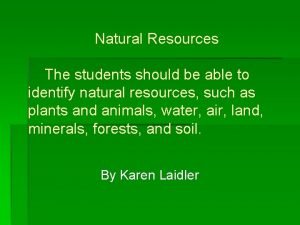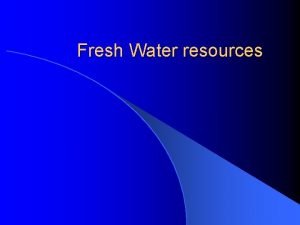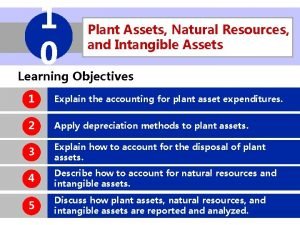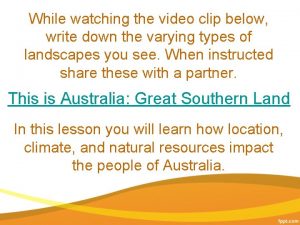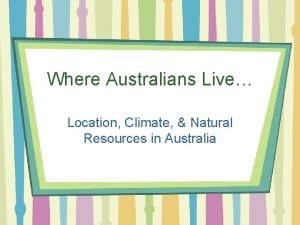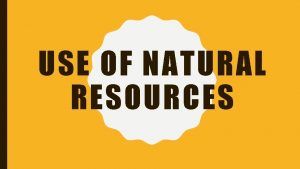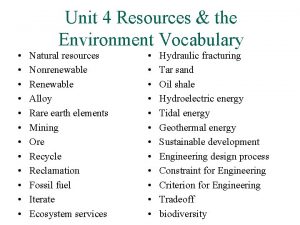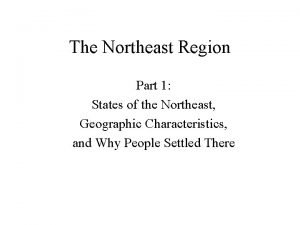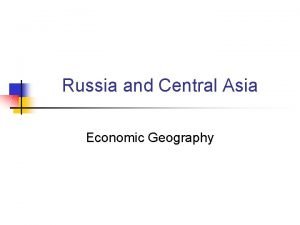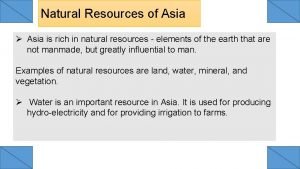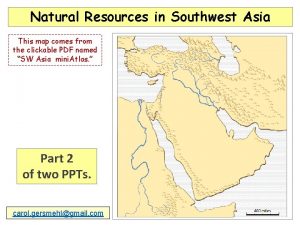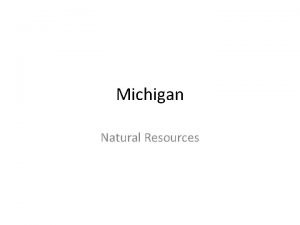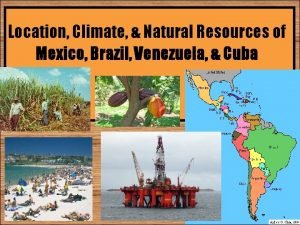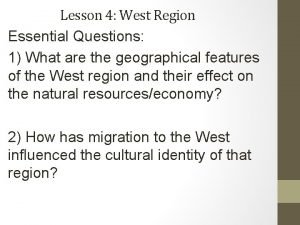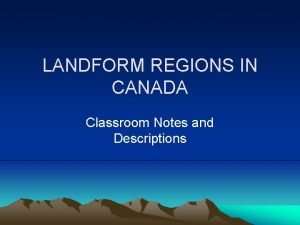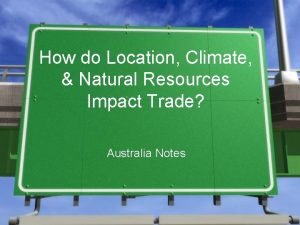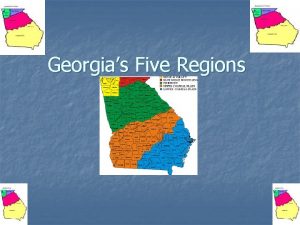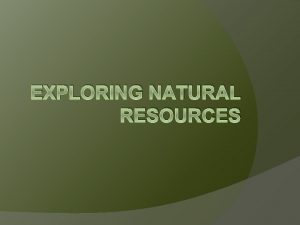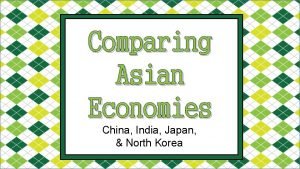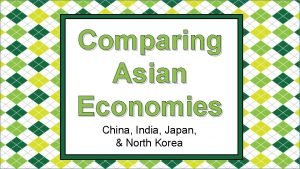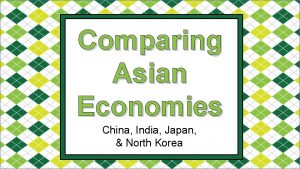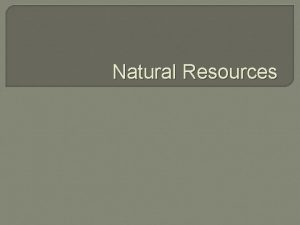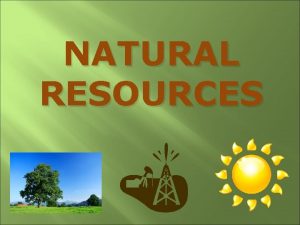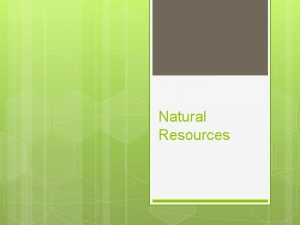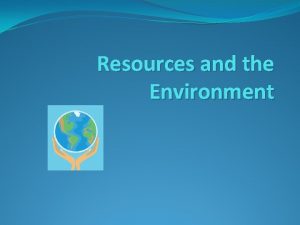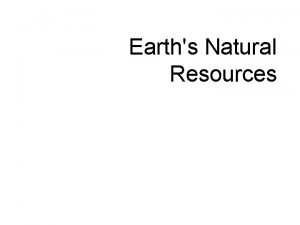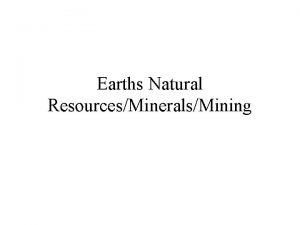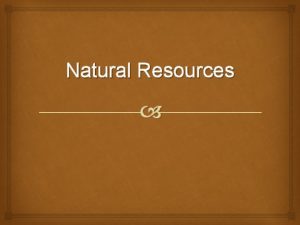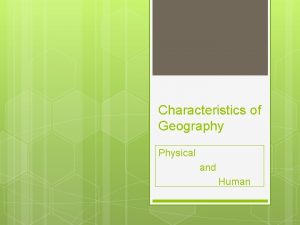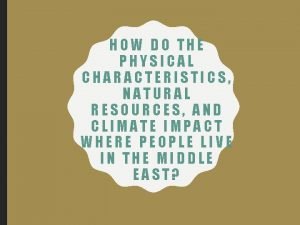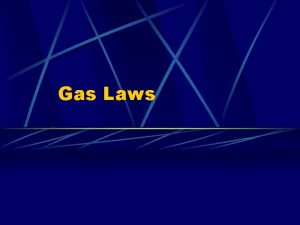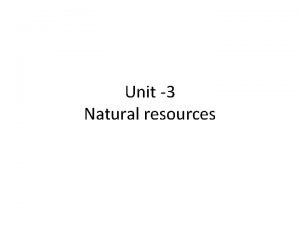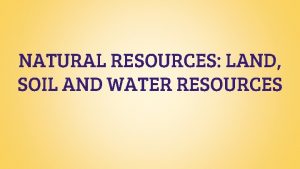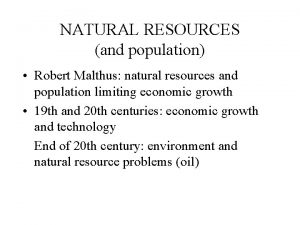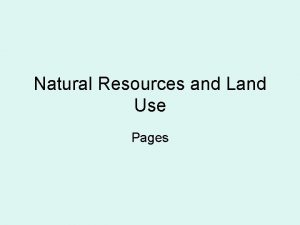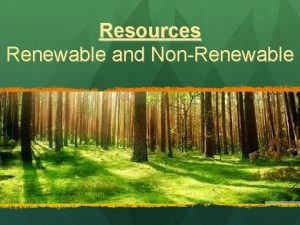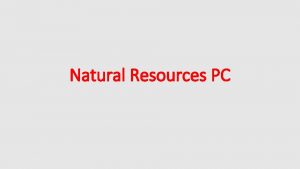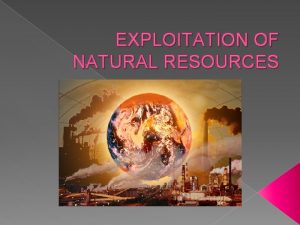HOW DO THE PHYSICAL CHARACTERISTICS NATURAL RESOURCES AND































- Slides: 31

HOW DO THE PHYSICAL CHARACTERISTICS, NATURAL RESOURCES, AND CLIMATE IMPACT WHERE PEOPLE LIVE IN THE MIDDLE EAST?

Standards: SS 7 G 7 a. Explain how the distribution of oil has affected the development of Southwest Asia (Middle East). SS 7 G 7 b. Describe how the deserts and rivers of Southwest Asia (Middle East) have affected the population in terms of where people live, the type of work they do, and how they travel.

IMPACT OF OIL AND PHYSICAL FEATURES ON THE MIDDLE EAST

PART I: CLIMATE IN THE MIDDLE EAST

HOW DOES CLIMATE AFFECT PEOPLE IN THE MIDDLE EAST? • Much of the Middle East is desert or very dry land; therefore, most cities and people are located near water. • There is little rainfall in the Middle East. Evaporation exceeds precipitation which makes the scarcity of water more serious. • There are huge stretches of desert where few people live or work.

IMPACT OF CLIMATE

PART II: TRANSPORTATION IN THE MIDDLE EAST

TRANSPORTATION IN THE MIDDLE EAST • Getting around the Middle East is often challenging. Many means of transportation have been adapted for different conditions. • Many countries use buses. However, the extent and condition of public transportation varies by country. Turkey has a more modern bus system whereas Iraq has an outdated system.

TRANSPORTATION IN THE MIDDLE EAST • In several countries, cars are used most frequently. In fact, countries such as Israel and Iraq have had to develop plans to deal with traffic jams and pollution from cars. • Turkey and Iran have extensive road systems and train systems that connect cities.

TRANSPORTATION IN THE MIDDLE EAST • Afghanistan has the least modernized system of transportation. Most cities lack public transportation. People ride on bicycles, pile into buses or trucks [even on the roofs], walk, or use donkeys, horses and camels.

TRANSPORTATION

PART III: WATER IN THE MIDDLE EAST

WHAT IS THE LINK BETWEEN WATER AND POPULATION DENSITY?

WATER IN THE MIDDLE EAST • The Middle East is mostly dry (arid) land or desert; therefore, the majority of people live near a source of water. • Large cities have grown near water sources such as rivers or along the coast. • Populations have grown around port cities as well because of employment opportunities in transportation, ship building, and repair. • There is little land for farming. If farming occurs, it occurs near rivers and river valleys or extensive irrigation is used.

IMPACT OF WATER

PART IV: DISTRIBUTION OF OIL

WHY IS OIL IMPORTANT? http: //www. theatlantic. com/video/archive/2013/08/ whats-in-crude-oil-and-how-do-we-use-it/278645/ How would our lives be different if we didn’t have oil?

According to the image below, 99. 8% of the world’s oil comes from the Middle East. What does this mean for countries in the Middle East? What is the problem then?



OIL IN THE MIDDLE EAST • Oil is not distributed equally in the Middle East. Some countries have a lot of oil and some countries very little oil. Identify a country in the Middle East that has a lot of oil. Identify a country in the Middle East that has very little oil. Is the oil concentrated in a particular area in the Middle East? Do you THINK people would live in a place with oil even if it doesn’t have the best physical features (including access to fresh water)? WHY?

WHAT ARE SOME OF THE BENEFITS OF HAVING OIL? • • • Oil-producing countries have enjoyed tremendous growth in national wealth and an improved standard of living. • Citizens that live in these countries may have the access to quality houses, food, health care, education, jobs, transportation, communication, and luxury items. The countries have used the money to build modern buildings, schools, factories, hospitals, etc. • Also, they have been able to pave old roads and build new ones. The life expectancy in these countries has increased by over 15 years because of advancements in healthcare, hospitals, medicines, education, etc.

OIL IN THE MIDDLE EAST • The sale of oil has earned extraordinary amounts of money for oil rich countries; however, not all countries have prospered. • Oil rich Iran and Iraq have suffered from war and the mismanagement of oil money; whereas, Saudi Arabia has used money from oil to transform from a poor society to a wealthy one.

Riyadh – Capital of Saudi Arabia

Kuwait City – Capital of Kuwait

Kabul – Capital of Afghanistan

School in Kabul, Afghanistan

HAVE NOT VS. HAVE Dubai Kabul, Afghanistan Yemen

WHAT IS THE LINK BETWEEN OIL FIELDS OR REFINERIES AND POPULATION DENSITY?

POPULATIONS ARE LARGER NEAR OIL FIELDS OR REFINERIES. CITIES GROW IN THESE AREAS AND MORE JOBS ARE AVAILABLE.

IMPACT OF OIL
 Difference between transforming and transformed resources
Difference between transforming and transformed resources Fixed resources examples
Fixed resources examples Natural asset companies
Natural asset companies Some natural resources, such as wheat and cattle, are
Some natural resources, such as wheat and cattle, are Natural resources in the canadian shield
Natural resources in the canadian shield Natural resources from landforms
Natural resources from landforms Plant assets natural resources and intangible assets
Plant assets natural resources and intangible assets Natural resources and population growth
Natural resources and population growth Natural resources and uses
Natural resources and uses Natural resources and associated problems
Natural resources and associated problems Agriculture and natural resources abbreviation
Agriculture and natural resources abbreviation Plant assets, natural resources, and intangible assets
Plant assets, natural resources, and intangible assets Renewable resources vs nonrenewable resources
Renewable resources vs nonrenewable resources Natural capital
Natural capital Australia major natural resources
Australia major natural resources Central australia natural resources
Central australia natural resources What are types of natural resources
What are types of natural resources Natural resources vocabulary
Natural resources vocabulary Northeast physical characteristics
Northeast physical characteristics Map of russia natural resources
Map of russia natural resources Natural resources in southeast asia
Natural resources in southeast asia Natural resources of southwest asia
Natural resources of southwest asia What is michigan's natural resources
What is michigan's natural resources What are cuba's natural resources
What are cuba's natural resources West region natural resources
West region natural resources Facts about st lawrence lowlands
Facts about st lawrence lowlands How does australia's location impact trade
How does australia's location impact trade Coastal plains attractions
Coastal plains attractions Types of natural resources
Types of natural resources Japan major natural resources
Japan major natural resources Japan natural resources
Japan natural resources Japan natural resources
Japan natural resources



